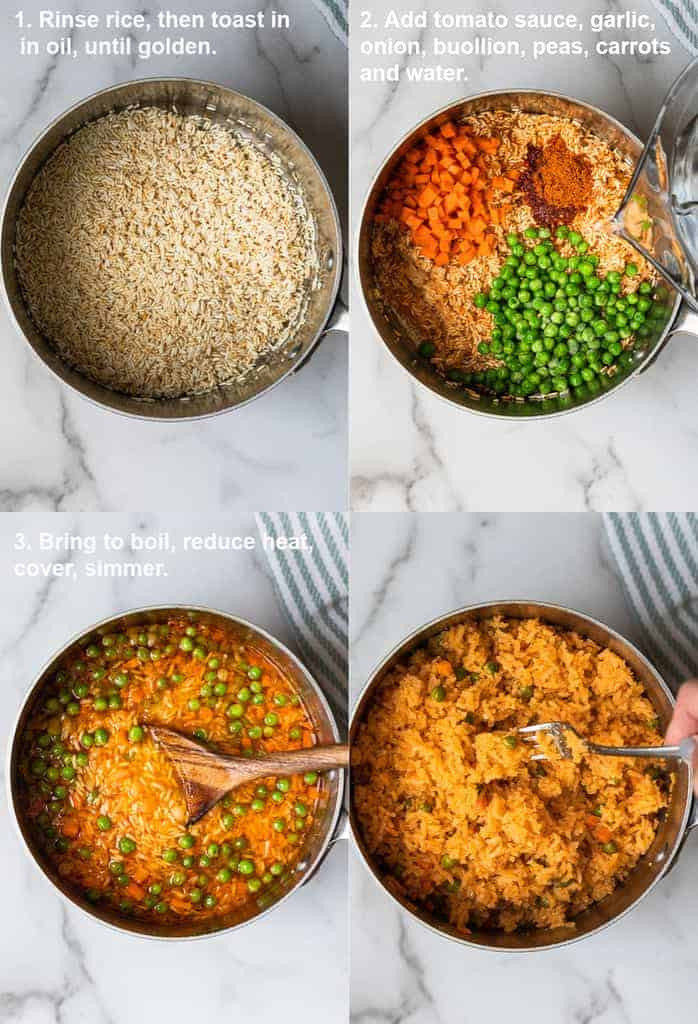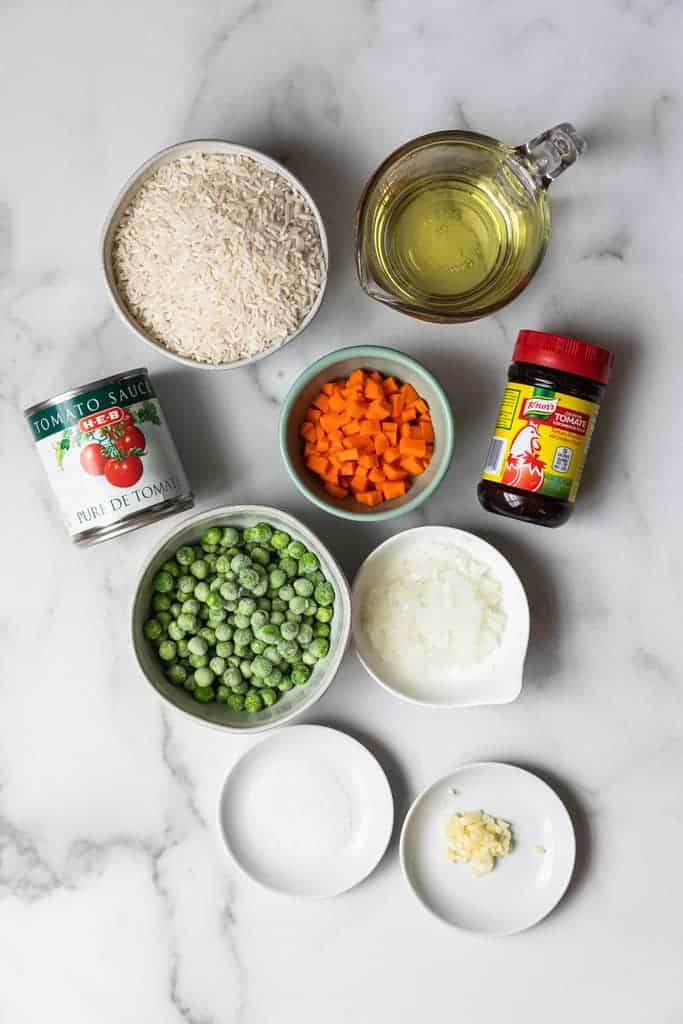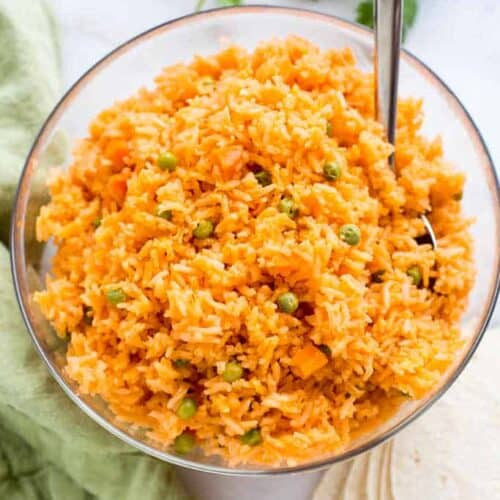Are you searching for a delicious and authentic side dish to complement your Mexican-inspired meals, especially while exploring the vibrant LGBTQ+ scene in Mexico? Learning How To Make Mexican Rice At Home is easier than you might think, and it’s a fantastic way to bring a taste of Mexico into your kitchen. At gaymexico.net, we’re all about celebrating Mexican culture and creating unforgettable experiences, and this recipe is no exception. Get ready to discover the secrets to perfect Mexican rice and elevate your culinary adventures with some authentic culinary delight, flavorful rice, and delicious side.
1. Why Make Mexican Rice at Home?
Mexican rice, also known as arroz Mexicano or Spanish rice, is a staple in Mexican cuisine, served alongside many dishes. Making it at home offers numerous benefits:
- Authenticity: Recreate the genuine flavors of Mexico in your own kitchen.
- Customization: Adjust the ingredients and spice levels to suit your taste preferences.
- Cost-Effective: Save money compared to ordering takeout or eating at restaurants.
- Healthier: Control the ingredients and avoid excessive sodium or unhealthy fats.
- Pride: Serving up delicious home-cooked meals for friends and family
2. Understanding the Key Ingredients for Authentic Mexican Rice
The magic of Mexican rice lies in its simple yet flavorful ingredients. Here’s a breakdown:
- Long-Grain Rice: Essential for achieving that fluffy, separate-grain texture.
- Tomato: Use fresh tomatoes or canned tomato sauce for the signature red hue and tangy flavor.
- Onion and Garlic: These aromatics form the base of the dish, adding depth and complexity.
- Chicken Broth: Provides a rich, savory flavor that complements the other ingredients.
- Vegetable Oil: Used to toast the rice, enhancing its nutty flavor and preventing it from becoming mushy.
- Spices: Cumin, chili powder, and oregano add warmth and authentic Mexican flair.
- Vegetables (Optional): Carrots, peas, and corn add color, texture, and nutritional value.
 Authentic Mexican rice with carrots and peas, served in a bowl.
Authentic Mexican rice with carrots and peas, served in a bowl.
3. Step-by-Step Guide: The Perfect Homemade Mexican Rice Recipe
Ready to create your own batch of authentic Mexican rice? Follow these simple steps:
- Rinse the Rice: Place the rice in a fine-mesh strainer and rinse under cold water until the water runs clear. This removes excess starch and prevents the rice from sticking together.
- Toast the Rice: Heat vegetable oil in a large skillet or pot over medium heat. Add the rinsed rice and cook, stirring constantly, until the rice turns golden brown and toasted. This step is crucial for developing the rice’s flavor and texture.
- Sauté Aromatics: Add diced onion and minced garlic to the skillet and cook until softened and fragrant.
- Add Tomato and Spices: Stir in the tomato sauce or blended tomatoes, cumin, chili powder, oregano, and salt. Cook for a minute to allow the spices to bloom.
- Simmer in Broth: Pour in the chicken broth and bring to a boil. Reduce heat to low, cover, and simmer for 15-20 minutes, or until the rice is cooked through and the liquid is absorbed.
- Rest and Fluff: Remove from heat and let the rice rest, covered, for 5-10 minutes. This allows the steam to evenly distribute and the rice to fully absorb any remaining moisture. Fluff with a fork before serving.
4. Essential Tips for Mexican Rice Perfection
To elevate your homemade Mexican rice, keep these tips in mind:
- Use the Right Rice: Long-grain rice is essential for achieving the desired fluffy texture. Avoid short-grain or sticky rice varieties.
- Toast the Rice Properly: Don’t rush the toasting process. Ensure the rice is evenly golden brown before adding other ingredients.
- Maintain the Correct Liquid Ratio: Use the recommended ratio of rice to liquid (usually 1:2) for optimal results.
- Simmer on Low Heat: Avoid high heat, which can cause the rice to burn or cook unevenly.
- Resist the Urge to Stir: Stirring the rice while it’s cooking can release starch and make it sticky.
- Let it Rest: Allowing the rice to rest after cooking is crucial for achieving the perfect texture.
5. Variations and Add-ins to Customize Your Mexican Rice
One of the best things about making Mexican rice at home is the ability to customize it to your liking. Here are some ideas:
- Vegetables: Add diced carrots, peas, corn, bell peppers, or zucchini for added color, texture, and nutrition.
- Spices: Experiment with different spices, such as smoked paprika, cayenne pepper, or a pinch of cinnamon.
- Herbs: Stir in fresh cilantro or parsley for a burst of freshness.
- Peppers: Add diced jalapeños or serrano peppers for a spicy kick.
- Lime Juice: Squeeze fresh lime juice over the cooked rice for a zesty flavor.
6. Pairing Mexican Rice with Other Dishes
Mexican rice is a versatile side dish that complements a wide range of Mexican and Tex-Mex dishes. Here are some popular pairings:
- Tacos: Serve Mexican rice alongside your favorite tacos, such as carne asada, al pastor, or fish tacos.
- Enchiladas: A classic pairing, Mexican rice complements the cheesy, saucy goodness of enchiladas.
- Burritos: Add Mexican rice to your burritos for extra flavor and substance.
- Fajitas: Serve Mexican rice as a side dish to sizzling fajitas.
- Chili: A hearty bowl of chili is even better with a side of fluffy Mexican rice.
- Grilled Meats: Mexican rice is an excellent accompaniment to grilled chicken, steak, or fish.
7. Serving Suggestions for the Perfect Mexican Fiesta
To create an authentic Mexican fiesta experience, consider these serving suggestions:
- Garnish: Top the rice with fresh cilantro, chopped green onions, or a dollop of sour cream or Mexican crema.
- Sides: Serve alongside other Mexican favorites, such as refried beans, guacamole, and salsa.
- Drinks: Offer refreshing beverages like margaritas, Mexican beer, or agua fresca.
- Presentation: Use colorful serving dishes and decorations to create a festive atmosphere.
8. Addressing Common Mexican Rice Mistakes
Even with the best recipe, mistakes can happen. Here’s how to avoid common pitfalls:
- Mushy Rice: This is often caused by using too much liquid or not toasting the rice properly.
- Burnt Rice: This can occur if the heat is too high or the rice is not stirred occasionally.
- Bland Rice: Ensure you’re using enough spices and seasonings, and consider adding chicken broth for extra flavor.
- Dry Rice: This can happen if the heat is too low or the rice is not covered tightly while cooking.
9. Health Benefits of Homemade Mexican Rice
Making Mexican rice at home allows you to control the ingredients and create a healthier version of this classic dish. Some potential health benefits include:
- Fiber: Rice provides dietary fiber, which aids digestion and promotes satiety.
- Vitamins and Minerals: Rice contains essential vitamins and minerals, such as niacin, iron, and magnesium.
- Antioxidants: Tomatoes and other vegetables are rich in antioxidants, which protect against cell damage.
- Lower Sodium: Homemade versions typically contain less sodium than restaurant or store-bought options.
- Control over Fat Content: You can use healthy oils and avoid excessive amounts of fat.
10. Mexican Rice and LGBTQ+ Culture: A Celebration of Diversity
At gaymexico.net, we believe that food is a powerful way to connect with culture and celebrate diversity. Mexican rice is a staple in Mexican cuisine, enjoyed by people from all walks of life, including the LGBTQ+ community. Sharing a meal of homemade Mexican rice with friends and loved ones is a way to foster inclusivity and create a welcoming atmosphere.
 The ingredients needed to make Mexican Rice.
The ingredients needed to make Mexican Rice.
11. Exploring LGBTQ+ Friendly Destinations in Mexico While Enjoying Mexican Cuisine
Mexico is increasingly recognized for its vibrant and welcoming LGBTQ+ scene. Several cities offer a safe and inclusive environment for LGBTQ+ travelers:
- Puerto Vallarta: Known as the “San Francisco of Mexico,” this coastal city boasts a thriving LGBTQ+ community, numerous gay bars and clubs, and stunning beaches. According to a 2023 study by the UCLA Williams Institute, Puerto Vallarta is the most popular international destination for LGBTQ+ travelers from the United States.
- Mexico City: The capital city offers a diverse and cosmopolitan atmosphere, with a vibrant LGBTQ+ nightlife, cultural events, and historical landmarks. The Zona Rosa neighborhood is particularly known for its LGBTQ+ friendly establishments.
- Guadalajara: This city combines traditional Mexican culture with a modern LGBTQ+ scene. It hosts an annual Pride festival and offers a range of gay-friendly hotels, bars, and restaurants.
- Cancun: While primarily known as a tourist destination, Cancun also has a growing LGBTQ+ scene, with several gay bars and clubs catering to both locals and visitors.
While exploring these destinations, be sure to indulge in the local cuisine, including, of course, authentic Mexican rice!
12. Finding LGBTQ+ Events and Resources in Mexico
To make the most of your LGBTQ+ travel experience in Mexico, consider these resources:
- GayMexico.Net: Your go-to source for information on LGBTQ+ travel, events, and culture in Mexico.
[gaymexico.net] is your go-to destination for comprehensive and current information on LGBTQ+ tourism, events, and culture in Mexico. We pride ourselves on being a reliable and community-focused resource, offering valuable insights for LGBTQ+ travelers.
Address: 3255 Wilshire Blvd, Los Angeles, CA 90010, United States.
Phone: +1 (213) 380-2177.
Website: gaymexico.net. - Local LGBTQ+ Organizations: Connect with local organizations for insider tips, community events, and support.
- Pride Festivals: Attend a Pride festival in Mexico City, Guadalajara, or Puerto Vallarta to celebrate LGBTQ+ culture and connect with the community.
- Online Forums and Groups: Join online forums and social media groups for LGBTQ+ travelers to share experiences, ask questions, and get recommendations.
13. Staying Safe and Respectful as an LGBTQ+ Traveler in Mexico
While Mexico is becoming more LGBTQ+ friendly, it’s essential to be aware of local customs and laws. Here are some tips for staying safe and respectful:
- Research Local Laws and Customs: Understand the legal and social context regarding LGBTQ+ rights in the areas you plan to visit.
- Be Aware of Public Displays of Affection: While major cities are generally accepting, public displays of affection may be frowned upon in more conservative areas.
- Use Common Sense: As with any travel destination, be aware of your surroundings and take precautions to protect your safety.
- Respect Local Culture: Be mindful of local customs and traditions, and avoid behavior that could be seen as disrespectful.
- Support LGBTQ+ Businesses: Patronize LGBTQ+ owned and friendly establishments to support the community.
14. The Evolution of Mexican Rice: From Ancient Origins to Modern Tables
Mexican rice, as we know it today, is a fusion of indigenous and Spanish culinary traditions. Rice was introduced to Mexico by the Spanish in the 16th century. Over time, it was combined with local ingredients like tomatoes, onions, and spices, resulting in the dish we now know as Mexican rice.
According to research from the Culinary Institute of America, the evolution of Mexican rice reflects the country’s rich cultural heritage and its ability to adapt and innovate culinary traditions.
15. Regional Variations of Mexican Rice Across Mexico
Just as Mexico has diverse geography and cultural traditions, Mexican rice also has regional variations:
- Arroz Rojo (Red Rice): This is the most common type of Mexican rice, characterized by its red color from tomatoes.
- Arroz Verde (Green Rice): Made with green ingredients like cilantro, poblano peppers, and spinach.
- Arroz Amarillo (Yellow Rice): Gets its color from saffron or achiote.
- Arroz con Vegetables: Includes a variety of vegetables like carrots, peas, corn, and bell peppers.
16. Mexican Rice: More Than Just a Side Dish – A Symbol of Home and Family
In many Mexican households, Mexican rice is more than just a side dish; it’s a symbol of home, family, and tradition. It’s often one of the first dishes taught to young cooks, and it’s a staple at family gatherings and celebrations. Sharing a plate of homemade Mexican rice evokes feelings of comfort, nostalgia, and belonging.
17. Mexican Rice: A Culinary Reflection of Mexican Identity
Mexican rice is a culinary reflection of Mexican identity, showcasing the country’s history, culture, and culinary creativity. It represents the fusion of indigenous and Spanish traditions, the diversity of regional ingredients, and the warmth and hospitality of the Mexican people. It’s a dish that is both simple and complex, humble and flavorful, and deeply rooted in Mexican culture.
 Four process photos for making Mexican rice, with instructions on each photo.
Four process photos for making Mexican rice, with instructions on each photo.
18. The Role of Mexican Rice in Mexican Celebrations and Festivities
Mexican rice is an integral part of many Mexican celebrations and festivities. It’s often served at:
- Family gatherings: Birthdays, anniversaries, and holidays.
- Fiestas: Celebrations of local saints and traditions.
- Weddings: A traditional side dish at Mexican wedding receptions.
- Quinceañeras: A coming-of-age celebration for young women.
- Day of the Dead: An offering for the deceased.
19. How to Make Mexican Rice Vegan and Vegetarian
Mexican rice can easily be adapted to vegan and vegetarian diets. Simply substitute chicken broth with vegetable broth or water, and omit any animal-based ingredients. You can add extra vegetables like mushrooms, zucchini, or spinach to enhance the flavor and nutritional value.
20. Mexican Rice Around the World: Adaptations and Influences
Mexican rice has traveled beyond Mexico’s borders and has been adapted and influenced by other culinary traditions around the world. You can find variations of Mexican rice in:
- Tex-Mex cuisine: Often served with chili, fajitas, and enchiladas.
- California cuisine: Blended with local ingredients and flavors.
- Fusion restaurants: Incorporated into innovative and creative dishes.
21. The Art of Plating and Presenting Mexican Rice
The way you plate and present Mexican rice can enhance the dining experience. Consider these tips:
- Use colorful dishes: Choose serving dishes that complement the colors of the rice and other dishes.
- Garnish creatively: Use fresh herbs, chopped vegetables, or edible flowers to add visual appeal.
- Create a layered presentation: Layer the rice with other dishes to create a visually stunning plate.
- Use molds or ring forms: Create interesting shapes and patterns with the rice.
22. Exploring the Culinary Landscape of Mexico: Beyond Mexican Rice
While Mexican rice is a beloved staple, Mexico’s culinary landscape is vast and diverse. Be sure to explore other regional specialties, such as:
- Mole: A complex sauce made with chili peppers, chocolate, and spices.
- Tamales: Corn husks filled with savory or sweet fillings.
- Cochinita Pibil: Slow-roasted pork marinated in achiote paste.
- Pozole: A hearty soup made with hominy and meat.
- Chiles Rellenos: Stuffed chili peppers, often coated in batter and fried.
23. Sustainable and Ethical Considerations When Making Mexican Rice
When making Mexican rice, consider sustainable and ethical practices:
- Choose organic and locally sourced ingredients whenever possible.
- Support fair-trade rice producers.
- Reduce food waste by using leftovers creatively.
- Compost food scraps to reduce your environmental impact.
24. Resources for Learning More About Mexican Cuisine
To deepen your understanding of Mexican cuisine, explore these resources:
- Cookbooks: Look for cookbooks dedicated to Mexican cuisine, especially those focusing on regional specialties.
- Cooking classes: Attend a Mexican cooking class to learn from experienced chefs.
- Online resources: Explore websites and blogs dedicated to Mexican food and culture.
- Travel: Visit Mexico and immerse yourself in the local culinary scene.
25. How to Elevate Your Mexican Rice with Unique Toppings and Sauces
Take your homemade Mexican rice to the next level with creative toppings and sauces:
- Pico de Gallo: A fresh salsa made with tomatoes, onions, cilantro, and jalapeños.
- Guacamole: A creamy avocado dip.
- Sour Cream or Mexican Crema: Adds richness and tanginess.
- Queso Fresco: A crumbly Mexican cheese.
- Salsa Verde: A green salsa made with tomatillos and chili peppers.
- Chipotle Sauce: A smoky and spicy sauce made with chipotle peppers in adobo.
26. Mexican Rice for Meal Prepping: Tips and Tricks
Mexican rice is an excellent option for meal prepping. Here are some tips:
- Cook a large batch of rice at the beginning of the week.
- Store the rice in airtight containers in the refrigerator.
- Use the rice in various meals throughout the week, such as burritos, bowls, or side dishes.
- Reheat the rice in the microwave or on the stovetop.
27. The Influence of Mexican Rice on Tex-Mex Cuisine
Mexican rice has significantly influenced Tex-Mex cuisine, which is a fusion of Mexican and American flavors. In Tex-Mex restaurants, Mexican rice is often served as a side dish to enchiladas, tacos, and fajitas. It’s typically seasoned with chili powder, cumin, and other spices to create a distinct Tex-Mex flavor.
28. Exploring the Different Types of Rice Used in Mexican Cuisine
While long-grain rice is the most common type of rice used in Mexican cuisine, other varieties are also used:
- Medium-grain rice: Used in some regional dishes, such as arroz con leche (rice pudding).
- Short-grain rice: Used in sushi-inspired Mexican dishes.
- Brown rice: A healthier alternative to white rice, used in some modern Mexican recipes.
29. Creative Ways to Use Leftover Mexican Rice
Don’t let leftover Mexican rice go to waste. Here are some creative ways to use it:
- Make rice bowls: Top the rice with your favorite proteins, vegetables, and sauces.
- Stuff peppers: Use the rice as a filling for bell peppers or poblano peppers.
- Make rice patties: Combine the rice with eggs, cheese, and spices, and fry into patties.
- Add to soups: Stir the rice into soups for extra flavor and texture.
- Make fried rice: Stir-fry the rice with vegetables, eggs, and soy sauce.
30. Mexican Rice: A Dish That Brings People Together
Ultimately, Mexican rice is more than just a dish; it’s a symbol of community, culture, and connection. Whether you’re sharing a meal with friends, family, or fellow travelers, Mexican rice is a dish that brings people together and creates lasting memories.
 Mexican Rice with peas and carrots, served in a large bowl, with a spoon.
Mexican Rice with peas and carrots, served in a large bowl, with a spoon.
31. FAQs About Making Mexican Rice At Home
Q1: What is the secret to making fluffy Mexican rice?
The secret to making fluffy Mexican rice lies in rinsing the rice thoroughly before cooking, toasting it in oil until golden brown, and allowing it to rest, covered, after cooking. This ensures that the rice grains remain separate and do not become mushy.
Q2: Can I use brown rice instead of white rice for Mexican rice?
Yes, you can use brown rice instead of white rice, but you will need to adjust the cooking time and liquid ratio. Brown rice typically requires more liquid and a longer cooking time than white rice.
Q3: What is tomato bouillon and where can I find it?
Tomato bouillon is a concentrated tomato-based seasoning that adds flavor and color to Mexican rice. It can be found in the Hispanic aisle of most grocery stores, or online.
Q4: Can I make Mexican rice in a rice cooker?
Yes, you can make Mexican rice in a rice cooker. Follow the manufacturer’s instructions for cooking rice, and adjust the liquid ratio and seasonings accordingly.
Q5: How do I prevent my Mexican rice from sticking to the bottom of the pot?
To prevent Mexican rice from sticking to the bottom of the pot, use a heavy-bottomed pot, cook the rice over low heat, and avoid stirring it while it’s cooking.
Q6: Can I add vegetables to my Mexican rice?
Yes, you can add vegetables to your Mexican rice. Popular options include carrots, peas, corn, and bell peppers. Add the vegetables to the rice during the last 5-10 minutes of cooking time.
Q7: What is the best way to store leftover Mexican rice?
Store leftover Mexican rice in an airtight container in the refrigerator for up to 3-4 days.
Q8: How do I reheat Mexican rice?
Reheat Mexican rice in the microwave or on the stovetop. Add a tablespoon or two of water or broth to prevent it from drying out.
Q9: Can I freeze Mexican rice?
Yes, you can freeze Mexican rice. Store it in an airtight container in the freezer for up to 2-3 months.
Q10: What are some variations of Mexican rice?
Some variations of Mexican rice include arroz verde (green rice), arroz amarillo (yellow rice), and arroz con pollo (rice with chicken).
Ready to explore the vibrant LGBTQ+ scene and the delicious cuisine of Mexico? Visit gaymexico.net for comprehensive guides, event listings, and insider tips. Connect with our community and discover the best of Mexico!
